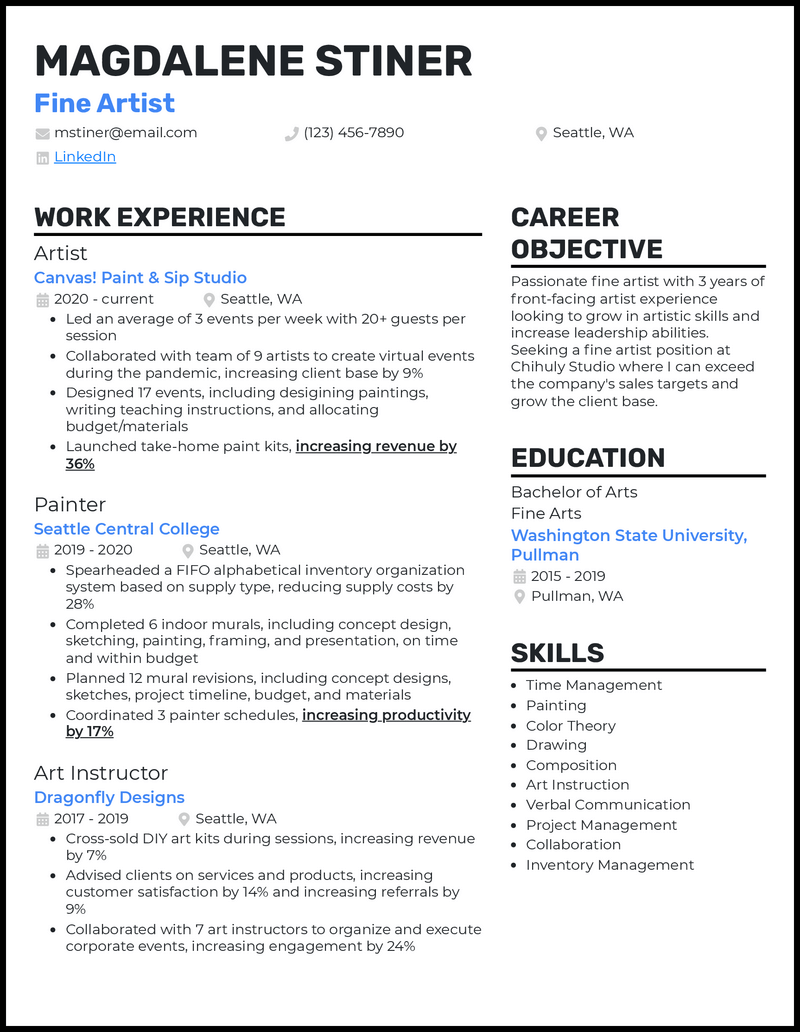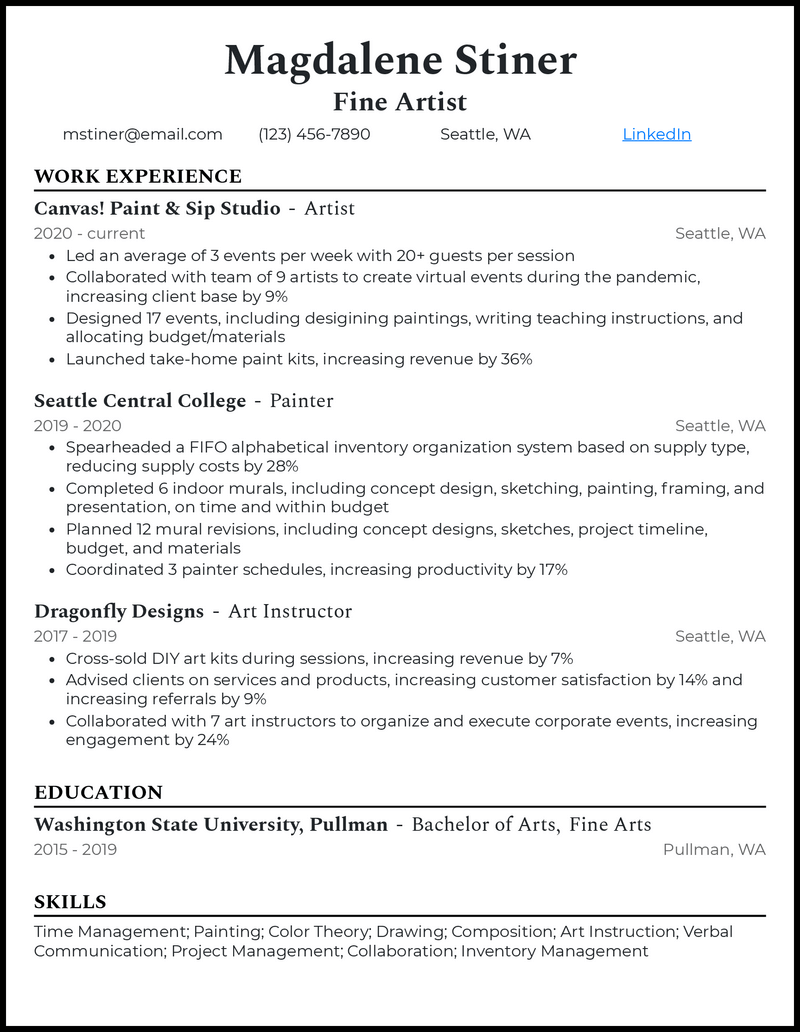As a fine artist, your craft could vary from intricate knitting, glassblowing, or sculpting to painting or drawing. You may even specialize in more than one thing or hybridize classic art forms to create something incredible from concept sketch to finished piece.
But is your resume template as fine a creation as your art? And what about writing an effective cover letter?
We’ve spent years helping people land careers in the arts and we’ll do the same for you! So take a breather and look through our three fine artist resume examples we’ve put together for you.
Copy this text for your fine artist resume!
Magdalene Stiner
Fine Artist
[email protected]
(123) 456-7890
Seattle, WA
CAREER OBJECTIVE
Passionate fine artist with 3 years of front-facing artist experience looking to grow in artistic skills and increase leadership abilities. Seeking a fine artist position at Chihuly Studio where I can exceed the company’s sales targets and grow the client base
WORK EXPERIENCE
Artist
Canvas! Paint & Sip Studio
2020 – current
Seattle, WA
– Led an average of 3 events per week with 20+ guests per session
– Collaborated with team of 9 artists to create virtual events during the pandemic, increasing client base by 9%
– Designed 17 events, including desigining paintings, writing teaching instructions, and allocating budget/materials
– Launched take-home paint kits, increasing revenue by 36%
Painter
Seattle Central College
2019 – 2020
Seattle, WA
– Spearheaded a FIFO alphabetical inventory organization system based on supply type, reducing supply costs by 28%
– Completed 6 indoor murals, including concept design, sketching, painting, framing, and presentation, on time and within budget
– Planned 12 mural revisions, including concept designs, sketches, project timeline, budget, and materials
– Coordinated 3 painter schedules, increasing productivity by 17%
Art Instructor
Dragonfly Designs
2017 – 2019
Seattle, WA
– Cross-sold DIY art kits during sessions, increasing revenue by 7%
– Advised clients on services and products, increasing
customer satisfaction by 14% and increasing referrals by 9%
– Collaborated with 7 art instructors to organize and execute corporate events, increasing engagement by 24%
SKILLS
– Time Management
– Painting
– Color Theory
– Drawing
– Composition
– Art Instruction
– Verbal Communication
– Project Management
– Collaboration
– Inventory Management
EDUCATION
Bachelor of Arts
Fine Arts
Washington State University, Pullman
2015 – 2019
Pullman, WA
Related resume examples
What Matters Most: Your Skills & Experience Sections

As a fine artist, many of your skills will revolve around the type of art you create and what medium you work with. But you’ll also want to include some interpersonal abilities and technical skills to present recruiters with an accurate snapshot of your well-rounded knowledge.
Everything you list should relate directly to how you create each masterpiece. Avoid anything generic like “teamwork” or “organization” when you can, and go for field-specific terms like “color theory” or “kiln safety”.
Be specific about each individual skill, too! Don’t use flat terms like “communication” when you could list “art presentation” or “art instruction” instead:
9 most popular fine artist skills
- Sculpture
- Kiln Firing
- Art Presentation
- Gallery Lighting
- Composition
- Painting
- Color Theory
- Project Management
- Drawing
Sample fine artist work experience bullet points
Amazing skills are like your artist brushes or sculpting tools. They’re wonderful things to have, but you won’t have a masterpiece on your hands without a process based in experience and practice.
Provide recruiters with a series of experience points that shows how you’ve put your fine art skills to good use! How did your finesse increase gallery or show attendance? When did you create art kits that boosted studio profits?
And make sure you pair those accomplishments with metrics! Recruiters need quantifiable data to back your success, like attendance rates, customer satisfaction percentages, and art show ratings.
Here are some samples:
- Cross-sold DIY art kits during teaching sessions, increasing revenue by 7%
- Collaborated with team of 9 other artists to create virtual events during the pandemic, increasing client base by an average of 6 new clients per week
- Spearheaded a FIFO alphabetical inventory organization system based on supply type, reducing supply costs by 28%
- Coordinated 3 painter schedules, increasing productivity by 17%
Top 5 Tips for Your Fine Artist Resume
- Beautify your layout
- Any of our three resume templates will showcase your qualifications nicely, but you’ll want to apply the same tasteful eye to your resume as you do to your work. Avoid any overkill with color, and stick with super readable fonts.
- Use testimonials
- Alongside your resume (and cover letter!), you might want to include some testimonials or recommendations in your application package. Professional references can come from mentors, previous employers, or art peers.
- About that cover letter . . .
- Whether you’re applying for an independent role or hoping to mentor other artists in a studio setting, a cover letter can show more about how you qualify. Give a couple strong examples of your previous achievements—just don’t repeat anything from your resume!
- Highlight that education
- Always remember to mention your Fine Arts degree, or whichever degree shows the highest level of education you’ve achieved. And don’t hesitate to include any other certifications that come from other classes, too.
- Don’t limit yourself
- While you definitely want to demonstrate a cohesive theme throughout your resume, don’t hide if you can do sculpture and paintings: Versatility makes any artist (and their resume) better!
Take another look at that job listing. Does the institution focus more on oil painting or composition and concept drafting? Tailor your resume around whichever specialties or keywords you find in the job description.
Some metrics are weaker than others, yes. If you completed a certain number of projects per month, that number will seem random unless it reinforces a snazzier metric like exhibit attendance rates or class profits.
If you have plenty of experiences that form a consistent theme, they may speak nicely for themselves! If you’re looking for a way to tie everything together, a resume summary could be for you. If you’re making a dramatic move in Fine Arts, try an objective!








